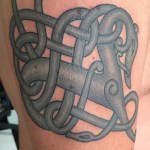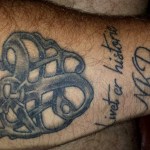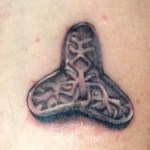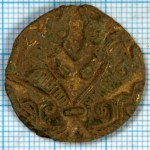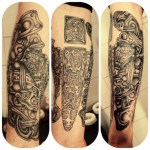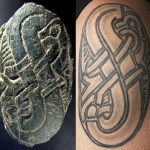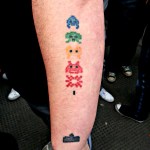tattoos
Detectorist John Kvanli is the chairman of Rygene detektorklubb and one of Norway's most prominent proponents of collaboration between amateurs and professionals in field archaeology. Of course he has a tattoo! It's an Urnes brooch from c. AD 1100, in the final exquisite Christian style of Scandinavian animal art.
John tells me he has found several fragments of these fragile objects, but the one inked onto his upper right arm is a settlement excavation find from Lindholm Høje, across the fjord from Aalborg in northern Jutland. The needlework was done by the Martin Tattoo Studio in Bangkok,…
René Lund Klee's tattoo
In our series of metal detectorist tattoos, where people put pictures of their best finds on themselves -- usually on their detector arms -- we now pay a visit to René Lund Klee. His tattoo depicts an Urnes brooch that he found on the Danish island of Lolland. The needlework was done there by Sandra's Ink in Nakskov.
Urnes brooch from Lolland
The Urnes style of c. AD 1050-1125 forms the end of the Scandinavian animal art tradition, which produced astonishing artistic riches during the Late Iron Age (c. 375-1125). Named for a Norwegian wooden church from the 1070s…
Jan Mortensen's tattoo
Another metal detectorist tattoo! This time it's Jan Mortensen who has decorated the arm with which he brandishes the detector. The object is a 10th century trefoil brooch that Jan found in Holbæk municipality, northern Zealand. Hugo Tattoo in Holbæk did the needlework.
Trefoil brooches were worn by South Scandinavian women as a third brooch, to close their cloaks. But the overall shape descended from high-end acanthus-decorated silver mounts for the bandoliers worn by Charlemagne's vassals around AD 800. Their trefoils joined the strap from the scabbard to the…
Torben Thomsen's tattoo
Torben Thomsen found this relief-decorated and gilded pendant in Hjørring municipality, northernmost Jutland. It was his first really old piece. Knight Ink Tattoo in Frederikshavn did the tattoo work on Torben's lower left leg. Torben's pendant is missing its loop, but his workmate Daniel Bach Morville has found the complete piece below at a nearby site.
The motif is a pair of antithetical sea horses. To date them, let's look at the animal art -- the two objects, not the tattoo. The tattoo artist has classicised the motif and gotten rid of a lot of specifically…
Two strap ends from the eponymous Borre ship grave. Image from Oluf Rygh's 1885 Norske Oldsager.
Metal detectorist Steffen Hansen has kindly given me permission to show you his tattoo sleeve. He found the strap-end at Øvre Eiker in Buskerud fylke, Norway, and had it tattooed along with other Norwegian examples of the Borre style. I haven't got a picture of his find, but you can see what they look like in the accompanying picture of a piece from the eponymous find at Borre in nearby Vestfold fylke. The tattoo was done by Mikael "Kula" Jensen of Radich Tattoo in Mjøndalen.
The Borre style is…
Yesterday I learned about a cool new tradition among metal detectorists. They're having images of their favourite finds tattooed, often on the arm with which they hold the detector! Note that in Scandinavia these are generally objects that the finders have handed in to museums – they keep them only as tattoos. This is in line with the Danish way of regulating metal detectors: there the submitters of each year's ten best finds are invited to the Finds Oscars in Copenhagen and are publicly honoured by my colleagues.
Hugo Falck found this beautiful brooch in 2014 while collaborating with a…
Junior and I met this guy in the line to the EuroGamer Expo in London last September. Anybody know him?
